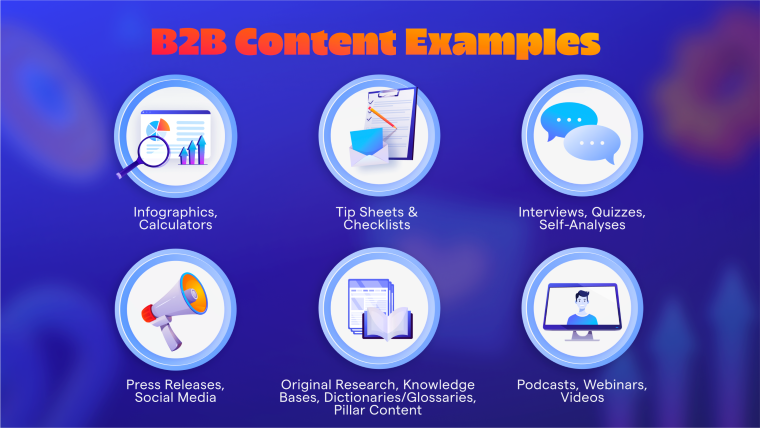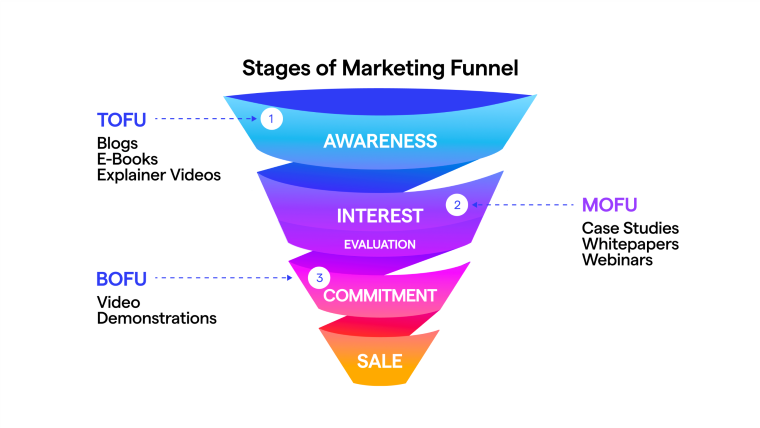
Since you’re dealing with longer sales cycles and multiple decision-makers instead of one, B2B content marketing is a lot more broad and comprehensive than its B2C counterpart.
In today’s article, I’ll show you the most important B2B content marketing examples to include in your strategy.
What makes B2B content different?
A B2B content marketing strategy is focused on building trust, authority, and thought leadership in your industry. Unlike B2C content, which focuses on selling a product or service directly, B2B content helps build relationships with the target audience through informative and educational content.
It’s about…
- educating potential clients/customers
- providing valuable insights and solutions to their pain points
- nurturing your leads until they’re ready to book a call
- giving your sales team the tools they need to close deals
- establishing leadership in your respective industry
The average B2B sales cycle lasts 104 days and includes 6 to 10 decision-makers. So, as a B2B marketer, your content strategy requires you to consider every potential decision-maker and their role, and each stage in your sales funnel.

In an October 2022 survey run by the Content Marketing Institute, 71% of B2B marketers said content marketing is only becoming more important. The more sales departments gravitate toward inside sales and buyers prioritize digital and self-service experiences, the more important your B2B content will be.
Written Content
Written content will make up a huge chunk of your B2B content marketing strategy.
- It’s the meat and potatoes of B2B SEO, so you’ll need it to maximize search engine visibility.
- It’s shareable, even between other companies in your industry.
- Text-based content is a huge part of the buying journey — 52% of B2B buyers say they’re “definitely” more likely to purchase after reading a vendor’s content.
A lot of the most important B2B content marketing examples fall under the ‘written’ category (especially if you’re starting from zero).
Let’s dive in.
Original Research
Original research includes whitepapers, ebooks, and blog posts detailing comprehensive studies. This content is valuable for prospects, current customers, and industry participants who might not buy your product (but would promote your content and thereby generate brand awareness).
My favorite B2B content marketing example in this category is Ahrefs’ well-known Links With Traffic study.
In this report, Ahrefs CMO Tim Suolo explores the correlation between a page’s or domain’s organic traffic and the value it passes to its backlinks.
Ahrefs has the best data in the entire SEO community. By taking the time to explore this topic, they’ve opened themselves up to industry wide promotion from other content creators and SEO professionals.
Including us…right now.
Most B2B companies also publish their own research around common industry topics.
Compt is a stipend, reimbursement, and employee perks software companies use to manage their benefits programs. Throughout the year, they use their wealth of employee benefits data to run perks and benefits studies.
In their most recent report — 2023 Mid-Year Perks Study — they address 2023’s employee benefits trends, how to benchmark them, and what competitors are doing to land the best talent in the game.
When your interested readers download it, they’ll receive a comprehensive PDF like this:
This is the stuff industry leaders ask for. And it’s ammo for your sales team.
Whether you’re a Compt customer or not, you can read the report and walk away with new information, ideas, and inspiration. That’s the whole point of original research.
Pillar Page
Pillar pages are your company’s core blog posts. They cover a broad topic that’s central to your business in-depth.
In a hub-and-spoke B2B content marketing strategy, you have pillar pages and topic clusters.
- Pillar pages are the backbone of your blog and SEO strategy. They’re the top of the pyramid and are usually 3,000+ words.
- Topic clusters cover long-tail variations of terms you want to rank for with each pillar page.
- The overarching goal here is to have Google’s algorithms recognize your site as a topical authority on that subject matter.
Let’s use Wowza’s Streaming Protocols page as our first B2B content marketing example in this category.
Wowza is a streaming media server platform streaming companies use to deliver video-on-demand (VOD) and live streaming content.
As you can see, Wowza’s pillar page covers everything related to streaming protocols.
- What is a streaming protocol?
- What are the most common ones?
- Which protocol is best for me, and what do I have to consider?
What I like about this pillar page is all the spokes are linked within the content, acting as sub-pillars.
The traffic potential is huge compared to its relative ranking difficulty.
And it’s Awareness-stage content, meaning it’s not pushy. It doesn’t try to sell Wowza straight away.
But, most of the spoke content is middle- or bottom-of-the-funnel, so a reader who lands on this page from a Google search could logically move through the purchase funnel.
Recently, we published our own pillar page for SaaS SEO:
B2B SaaS companies are a huge part of our clientele, so an in-depth report like this just makes sense.
Blog Post
Your company blog is where you get to cover all the topics within your pillar pages (and much more).
Here are a few things you’ll want to include in your blog section of your B2B content marketing strategy.
- Residual topics. For example, this article about B2B content examples.
- Product-led content. Every use case or potential need for your software can have its own blog post.
- Targeted keywords. Optimized and properly promoted blog posts are the #1 way to build search visibility.
- News and events. What cool things are happening in your company?
- Product updates. The ins and outs of every feature you roll out.
- Industry insights. Commentary on industry news, events, or trends (or a combination thereof), plus how they affect your customers.
If I were you, I’d start with the product-led and solution-oriented content (e.g., “How to Solve X with Y” or “X Strategies for Y in 2024”).
News, events, etc., are valuable for scaled B2B companies like Salesforce, but your customers probably don’t care.
Email content is the groundwork for lead nurturing, but that doesn’t mean it can’t stand on its own.
Your email B2B content marketing strategy should include:
- Newsletters. Like short blog posts, but in your subscriber’s inbox.
- Promotional mailings. New product releases and updates, free trials or demos, discounts (if you’re into that kind of thing), and other ‘subscribe now’ CTAs.
- Autoresponders. Welcome series, abandoned cart emails, and lead nurture sequences are just the beginning.
Here’s a look at a post-sales-demo autoresponder from Deeto, a SaaS startup selling customer advocacy software. By clicking through, prospects can literally join the system and see it from the client side (which is great for conversions!).
Firstbase sends its users new articles, studies, promotional discounts, and company news through its newsletter.
Trello uses playful copy in its onboarding emails, which drive product adoption and show their new users around. They even have links to all of the tool’s sub-content for easy navigability.
Email content should be buried and fun to read — but more importantly, it should be informative and actionable. It’s a direct communication channel to your customers, so it’s your opportunity to show your company’s personality to current and potential customers.
Case Study
Case studies are the most coveted type of B2B content because they’re pure social proof. In fact, 88% of B2B content marketers say case studies are more influential than any other type of content.
Here’s a great example from Gong, the popular revenue intelligence and sales enablement platform:
Before the first scroll of a case study page, do exactly as this B2B content marketing example did.
- An eye-opening statistic. Your reader should feel like you could be their “MVP” and all they have to do is book a demo. Use Gong’s engaging headline as inspiration.
- A challenge. Every customer has pain points. What was theirs? Frame it as “Company X approached YOU. Here’s why:”
- An outcome. Your product has multiple features. Focus on one main benefit.
- Multimedia. This case study page is great because I don’t have to read it if I don’t want to. I can click on the video if I prefer.
Throughout the case study, they do everything right. From a UI, copywriting, and media standpoint.
- Wording like “We grow together.” signifies inclusivity and partnership. Believe it or not, this small touch makes a huge difference because it’s what every company cares about.
- The language and tone are conversational and relatable, while still showcasing the success of their product.
- There are live video testimonials from the platform’s core users.
- Quotes from high-ranking execs add credibility.
- There’s always a “Book a Demo” CTA in the upper right corner, so readers can convert ON THE SPOT.
Bravo, Gong.
Glossary
Glossaries are a bit of an SEO cheat code (although more and more B2B marketers seem to know about them).
First, you can capitalize on long-tail keywords (e.g., “What is account-based selling?”). Over time, ranking for so many keywords helps you build authority.
And, glossary-style content is easy to produce and update. You just list terms in alphabetical order and provide long-form definitions (i.e., blog 1,500-word blog posts).
DealHub is a CPQ software vendor. They absolutely crush it with their glossary. It lands them tens of thousands of unique organic visitors every month.
Over the last 365 days, they’ve 6X’ed their monthly organic traffic.
While these are, for the most part, top-of-funnel content assets for B2B companies, they are also a great resource for current and potential customers.
And, when they show up on SERPs, they generate brand awareness.
So, creating content like this is definitely worth the investment.

Visual Content
More than half of B2B marketers use visual elements in 90%+ of their content. As a content marketer myself, you probably aren’t producing high-quality content unless there’s some sort of visual aspect.
- It’s easy for your readers to understand.
- It’s also easy for them to share.
- You can repurpose it across your social media channels and use it for other parts of your digital marketing strategy
- It’s not usually expensive to produce — most content marketing budgets can handle it.
Here are my visual content marketing MUSTS:
Video
Although text performs quite well for B2B companies, video content is an absolute must. It adds context to everything — you can demo your product, introduce your team, and more.
One place I really like video content is above the scroll on landing pages. It gives your viewer the opportunity to explore your product or compare without reading a long page of text and images.
ClickUp does this on almost all of its landing pages.
On all of the company’s service pages, animations automatically play an animated video that show how each product feature works. Check it out.
On the company’s YouTube, they include productivity hacks and helpful how-tos that engage their current and future customers.
<embed>
And, they post short-form content for Shorts, Reels, and TikTok (which is probably the biggest opportunity for content creation right now).
<embed>
The thing is, creating content like this isn’t even cost- or labor-intensive. Most of the content they publish can be filmed with a smartphone or a $5 Loom video subscription and edited in seconds with AI.
In some cases, your customers will literally do it for you.
Infographic
When you create content for your blog, infographics are your best friend.
You might have seen a few in our other blogs already, like this one where I compare demand generation vs. lead generation…
Yes. I explained the concept in words. But it’s 100X easier for your audience to understand when you include a picture as well.
Infographics are also great for publishing statistics in a digestible way. Whenever you publish your own research, you should include an infographic for some of your most important statistics.
Then, slap your logo on it like this:
Once others cite your information in their arguments, your logo will be sitting on their website forever. At scale, this really helps with awareness and authority.
You should also publish long-form infographics for distribution via your social channels (and other sites like Forbes for PR).
These types of infographics are supposed to simplify a complex topic or present data and stats in an easy-to-digest way (as opposed to a wall of text against a white backdrop).
You can also repurpose portions of them for other relevant content.
Here’s an example of one from Salesforce that details customer service trends:
You can view the whole infographic here.
Interactive Experience
Interactive experiences are one of the best ways to drive engagement, gather data, and provide value to your audience. They’re also great for lead generation — you might be able to get email addresses from interactive tools.
The best interactive tools include:
- Quizzes
- Calculators
- Graders
- Assessments
HubSpot’s website grader is the perfect example of this. It asks for your URL and email address, then returns a comprehensive report of how effective your website is at ranking.
Depending on your company’s product, you might be able to create something similar — maybe a calculator that tells potential customers how much money they could save using your solution or an assessment that helps them understand the weaknesses in their current processes.
Tutorial
Tutorials are great for educating your audience and demonstrating how to use your product.
Think about it this way: if your software isn’t easy enough for customers to figure out on their own, why would they continue to use it?
So, you need tutorials for customer retention.
Plus, they’re super versatile — you can create step-by-step written instructions or video tutorials (or a combination of both).
My favorite example of tutorial content is SEMrush’s Academy.
The company goes above and beyond, publishing hundreds of lessons on how to use their product, as well as general digital marketing education.
It not only helps their customers make the most out of their subscription, but it also positions them as thought leaders in the industry and gets new potential SEOs and marketers hooked on their product instead of a competitor’s.
You might not have an entire industry built around your product like Semrush, but you can easily publish product how-tos on YouTube with free tools like Loom.
Here’s a look at a training video from Notion, the well-known project management and note-taking tool.
<embed>
They host a full series of these videos on their YouTube channel, along with other helpful content — like productivity hacks — for customers and potential customers alike.
Calculator
Calculators show your customers how much of a return they can expect when using your product or service.
This metric is especially powerful for B2B companies, as most of their purchases are based on ROI.
The HubSpot Marketing Hub ROI calculator is one of the best. It shows potential customers how much revenue they could generate from using a marketing automation tool, based on their current website traffic and conversion rates.
It also breaks down your results and gives you a comprehensive report. This is important because reporting and breakdowns play a huge role in exec buy-in.
Your calculator doesn’t need to be this complex or detailed. You just need to show potential customers how much value they can get from using your product or service.
Meme
Memes are great for lightening the mood and showing off your company’s personality. They’re also meant to…
- boost your audience engagement
- educate and ‘wow’ them
Sales enablement platform Dooly makes some pretty funny ones for their company socials.
For example, the joke here is Salesforce population is something Dooly handles automatically:
In this LinkedIn post, Dooly not only created a funny meme, but also asked an engaging question to its viewers.
By getting the audience involved and encouraging comments, it ended up with 11,005 engagements (“likes”), 393 comments, and 480 reposts.
That’s quite a lot.
Memes have plenty of different content formats, so they are sometimes tough to create, (specially if your team members aren’t ~in the know~).
The good news is, they’re so ubiquitous that you can pick from one of hundreds of meme templates (use a tool like Memematic) and apply it to just about any topic you can imagine.
No ideas? Use ChatGPT.
The best way to ensure success with this type of content is to stay relevant to your industry and audience, and make sure it’s not offensive in any way.
Creating B2B content is half the battle…
The other half is getting others to see it.
Oh yeah…we can help with that!

Brittney Fred, SEO Analyst
Brittney has been working in SEO and digital marketing for ten years and specializes in content strategy for the B2B SaaS industry. She is based in Denver, CO and absolutely fits the Denverite stereotype. You’re just as likely to find her hiking, snowboarding, or doing yoga as reading sci-fi or playing video games.
